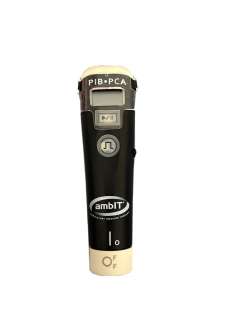Launch of the ambIT Pain Control Pump
September 12, 2023 | Natale Naim, MD

The Acute Pain Service at UCLA Santa Monica Medical Center implemented a new peripheral nerve catheter pump system called ambIT in June 2023. The DAPM Handoff interviewed Natale Naim, MD, DAPM Chief of Regional Anesthesiology and Orthopedics, about this exciting development.
What is the ambIT electronic pain control system, and what are its benefits over the On-Q pump?
The ambIT electronic pain control system is used in conjunction with peripheral nerve catheters to optimally deliver local anesthetics for the treatment of pain. It allows patients to engage in their care with either basal/bolus or intermittent bolus setting options. The goal is to offer better pain relief, especially with fascial plane catheters, where it has been proven in the Regional Anesthesia literature to be superior in the treatment of pain. From 2014 until now, the On-Q outpatient peripheral nerve catheter pump had been our primary peripheral nerve catheter infusion device, but it had allowed only a continuous infusion setting. In 2023, we were able to convince UCLA to approve the ambIT system for our clinical use.
How did you first hear about the ambIT pump? How did the idea to start using it at UCLA first arise? What were the steps you needed to take to implement the change? Who was involved with this process?
The medical device company, Avanos, is the producer of the On-Q pump that we have used for almost the last 10 years in a total of about 10,000 cases. AmbIT is the natural upgrade to the On-Q pump, with greater patient and provider options, allowing better pain control. Given that we had 10 years of data on the On-Q pump and many of the practitioners who were using it (including myself), the evidence of benefit was easy to present. The Value Analysis Committee analyzed the device, costs, and benefits, and approved the device. It took approximately one year for nursing approval and another 6 months of nursing education before the device was in full use at Santa Monica Hospital. The plan is to establish firmly the program at Santa Monica Medical Center and then begin training at Ronald Reagan Medical Center.
Can you tell us about the history of the use of peripheral nerve block catheters at UCLA and at other medical centers nationwide?
Peripheral nerve catheters with delivery systems that required patients to remain inpatients began in the late 1990s. The year 2014 marked the change to outpatient delivery systems. Patients could then have surgery, take their nerve catheter and pump home, and then remove it themselves several days later according to physician instructions. This was pivotal in changing the landscape of joint replacements at UCLA. What were traditionally 3- to 7-day inpatient admissions were now becoming 1- to 2-day stays or even same-day discharges. With the COVID-19 pandemic, further protocols were created, transitioning total knee arthroplasties to 45% same-day surgeries, well above the national average.
How do you think the ambIT pump will help improve postoperative care (and facilitate the postoperative goals of anesthesiologists, surgeons, and the patients themselves)?
The goal with any pain delivery system is to build and improve upon the current care patients are receiving. With ambIT, we are expecting to continue to transition many postoperative admissions for pain control to significantly improved perioperative analgesia and same-day discharge. The ongoing bed shortage in hospitals and the opioid epidemic crisis are two very strong reasons to continue to push the envelope in optimizing not only intraoperative pain, but also postoperative pain and the prevention of the transition to chronic pain.